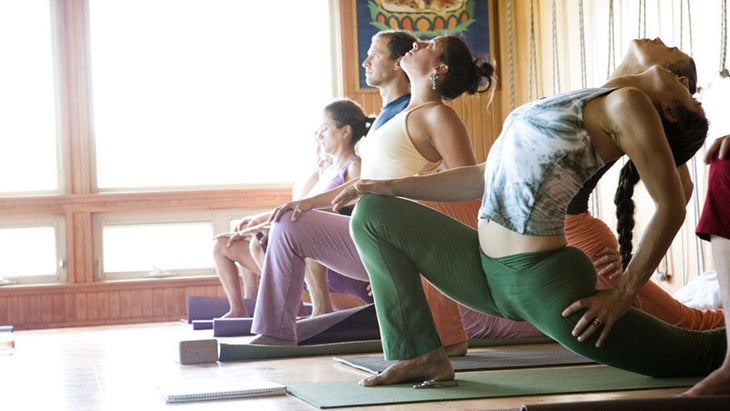Heading out the door? Read this article on the new Outside+ app available now on iOS devices for members! Download the app.

Some students equate a good yoga class with a fast one, but moving too quickly can lead to injuries. Here, 3 signs it’s time to slow down.
It’s somewhat taboo to say you want to get a good “workout” from your yoga class, but let’s face it, a lot of people do. “People do want to work out. We call it a ‘work in,'” says Eddie Modestini, a longtime student of K. Pattabhi Jois and B.K.S. Iyengar, who will lead Yoga Journal’s upcoming online course, Vinyasa 101: The Fundamentals of Flow. (Enroll here, and be the first to know when this essential guide to vinyasa yoga is launched.)
However, some students equate a good workout with a fast one, and that doesn’t have to be the case, Modestini says. Plus, moving too quickly can lead to injuries.
3 Signs Your Yoga Practice Is Too Fast
1. You’re moving faster than your breath.
“You can’t move faster than your breath,” he explains. “The rate of the breath is the rate of the movement. If the movement is faster than the breath, inhalation or exhalation, then you’re not connecting the mind to the body and the body to the breath.”
The best way to make sure you’re not moving too fast? Focus on the breath. “When a teacher says, ‘Inhale, lift your arms up,’ a more complete cue would be, ‘Inhale, lift your arms at the rate of your slow, smooth, even inhale,'” he says. “If you inhale so fast, you’re going to injure yourself. Doing it at the rate of your breath is safer. People get hurt when they move without breathing.” Each inhalation and exhalation during your yoga practice should be slow, smooth, and even.
See also Transform Your Practice With Better Breathing
2. You’re trying to keep up with the person next to you.
Another thing that leads to excess speed—and injuries: Trying to keep up with the practitioner standing next to you. “You can’t compare yourself to somebody else in the class, who maybe practiced ballet for 7 hours a day for 14 years,” Modestini warns.
3. You’re building too much heat.
Speed isn’t always the culprit when it comes to injuries. Heat may limit your ability to be sensitive to yourself, Modestini says. “Heat expands your threshold. You can go deeper, longer, and faster with the heat, and that can hide your restrictions and your level of flexibility. Getting really hot once a week and really pushing it is more dangerous than building a little heat every day and practicing regularly.”
See also Vinyasa 101: 4 Ways to Avoid Yoga Injuries
The Need for Speed
All of that said, speed can actually be a good thing for some students, when practiced safely. “Yoga is quieting the mind—you can move fast and still quiet the mind. The craziest people need to move fast. K. Pattabhi Jois’ prescription for insanity was 12 rounds of Surya Namaskar A and 12 rounds of Surya Namaskar B, twice a day. You move the body quickly to quiet the agitated mind.”
Eddie Modestini is the co-director and co-owner of Maya Yoga Studio in Maui. Want to learn more ways to injury-proof your practice, whether you’re a teacher or a student? Sign up for Modestini’s upcoming Vinyasa 101 course, which will cover the anatomy of the spine, how to adapt asana for various body types, and much more.